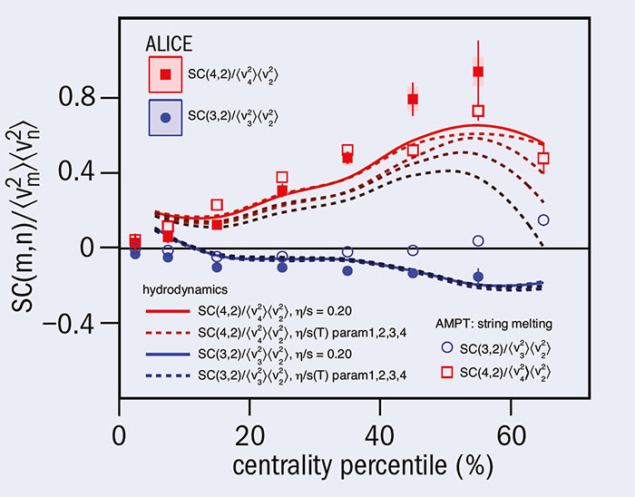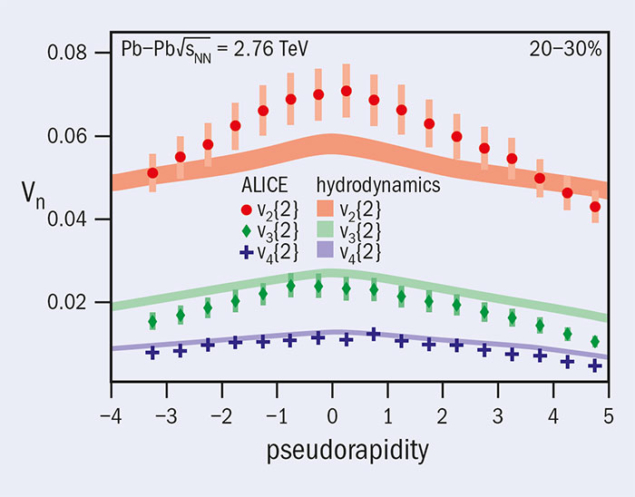
” width=”700″ height=”548″/>
The correlation of vn as a function of centrality, which is related to the amount of overlap of both lead ions at the time of the collision: solid red points are positive, while negative correlations are shown in blue.
One of the key goals in exploring the properties of QCD matter is to pin down the temperature dependence of the shear-viscosity to entropy-density ratio (η/s). In the limit of a weakly interacting gas, kinetic theory indicates that this ratio is proportional to the mean free path. Many different fluids exhibit a similar temperature dependence for η/s around a critical temperature Tc associated with a phase transition.
Heavy-ion collisions at the LHC create a state of hot and dense matter where quarks and gluons become deconfined (the quark gluon plasma, QGP). It exists within the initial instants of the collision, then as the system cools, the quarks and gluons form a hadronic gas at Tc. The temperature dependence of η/s is expected to follow the trend of other fluids, with a minimum at Tc. The minimum value of η/s is of particular interest because weakly coupled QCD and AdS/CFT models predict different values.
Measurements of vn versus the pseudorapidity of produced charged particles, with lines indicating hydrodynamical calculations tuned with RHIC data.
The ALICE collaboration has recently released results from anisotropic-flow measurements, which provide new constraints for η/s(T). Anisotropic flow results from spatial anisotropies in the initial state that are converted to momentum anisotropies via pressure gradients during the evolution of the system. The magnitudes of momentum anisotropies are quantified by the so-called vn coefficients, where v2 is generated by initial states with an elliptic shape, v3 a triangular shape, etc. The shape of the initial state fluctuates on an event-by-event basis.
Our results show that the average temperature of the system decreases with the pseudorapidity magnitude (figure, above), which means that measurements at forward rapidities are more sensitive to the hadronic phase. Although the model calculations reproduce the general trends of the data, it is clear that other parameterisations of η/s(T) could be explored to better describe the RHIC and LHC data simultaneously.
The correlation of vn as a function of centrality, which is related to the amount of overlap of both lead ions at the time of the collision: solid red points are positive, while negative correlations are shown in blue.
We also measured event-by-event correlations of different vn coefficients in lead–lead collisions (figure, left). It is clear that the v2 and v4 correlations are rather sensitive to different parameterisations. By contrast, the correlation between v2 and v3 is not, and is largely sensitive to how the initial state is modelled. Subsequently, it was found that the agreement improved as the number of degrees of freedom in the initial model was increased. Whether the deviations between data and model for the v2 and v4 correlation are due to the η/s(T) parameterisations or the initial-state modelling will be the subject of future study.










